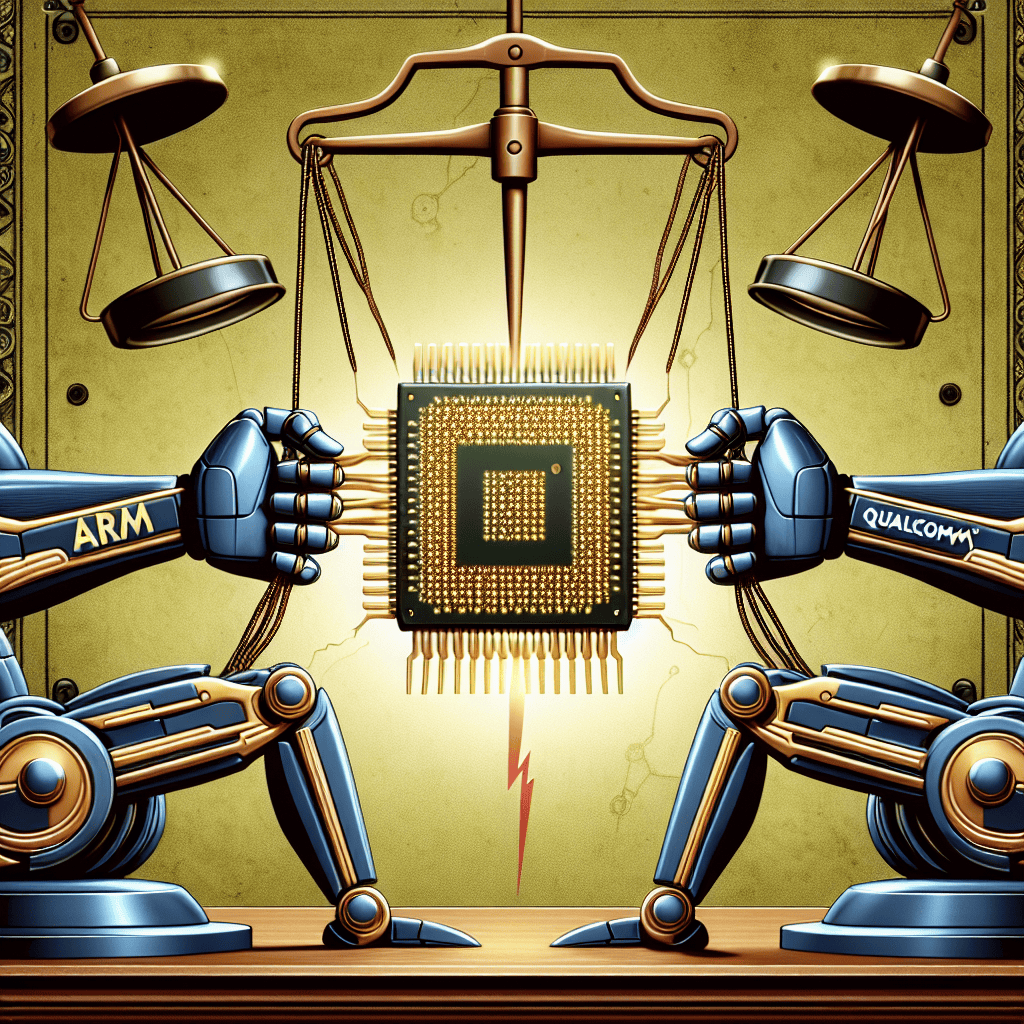“Arm’s Bold Move: Cutting Ties, Redefining the Chip Design Battlefield”
Introduction
Arm, a leading semiconductor and software design company, is reportedly planning to terminate its chip design license agreement with Qualcomm, a major player in the mobile and telecommunications industry. This move comes amid escalating tensions and legal disputes between the two tech giants. The conflict centers around licensing terms and intellectual property rights, with Arm seeking to assert greater control over its technology and revenue streams. The termination of the license could have significant implications for Qualcomm, potentially disrupting its supply chain and affecting its ability to produce cutting-edge chips for smartphones and other devices. This development highlights the growing complexities and competitive pressures within the semiconductor industry, as companies vie for technological dominance and market share.
Overview Of The Arm And Qualcomm Dispute
The ongoing dispute between Arm and Qualcomm has reached a critical juncture, as Arm has announced its decision to terminate Qualcomm’s chip design license. This development marks a significant escalation in the conflict between the two technology giants, which has been simmering for some time. To understand the implications of this move, it is essential to delve into the background of the dispute and the potential consequences for both companies and the broader semiconductor industry.
Arm, a leading designer of semiconductor chips, provides the architecture that underpins a vast array of devices, from smartphones to servers. Qualcomm, on the other hand, is a major player in the semiconductor industry, known for its Snapdragon processors that power many of the world’s smartphones. The relationship between Arm and Qualcomm has historically been symbiotic, with Qualcomm relying on Arm’s architecture to develop its chips. However, tensions have been rising due to disagreements over licensing terms and the use of Arm’s intellectual property.
The crux of the dispute lies in Arm’s assertion that Qualcomm has violated the terms of its licensing agreement. Arm alleges that Qualcomm’s acquisition of Nuvia, a startup founded by former Apple chip designers, and its subsequent integration of Nuvia’s technology into its own products, constitutes a breach of contract. Arm contends that Qualcomm’s actions have circumvented the licensing framework, thereby infringing on Arm’s intellectual property rights. Qualcomm, however, disputes these claims, arguing that its use of Nuvia’s technology is within the bounds of its existing agreements with Arm.
As the dispute has intensified, Arm’s decision to terminate Qualcomm’s chip design license represents a bold move that could have far-reaching implications. For Qualcomm, the loss of access to Arm’s architecture could disrupt its product development pipeline, potentially affecting its ability to deliver new and competitive chips to the market. This could have a ripple effect on Qualcomm’s customers, including major smartphone manufacturers, who rely on Qualcomm’s processors for their devices.
Moreover, the termination of the license could prompt Qualcomm to explore alternative architectures, such as RISC-V, an open-source instruction set architecture that has been gaining traction in the industry. While this could foster innovation and diversification in the semiconductor market, it also presents significant challenges for Qualcomm, as transitioning to a new architecture would require substantial investment in research and development.
For Arm, the decision to terminate the license is not without risks. While it underscores Arm’s commitment to protecting its intellectual property, it also raises questions about the company’s willingness to engage in collaborative partnerships. In an industry where cooperation and cross-licensing are common, Arm’s hardline stance could deter potential partners and customers, potentially impacting its market position.
In conclusion, the termination of Qualcomm’s chip design license by Arm is a pivotal moment in the ongoing dispute between the two companies. As the situation unfolds, it will be crucial to monitor how both parties navigate the challenges and opportunities that arise from this decision. The outcome of this dispute could reshape the dynamics of the semiconductor industry, influencing the strategies of other companies and the development of future technologies. As such, stakeholders across the industry will be watching closely to see how this high-stakes conflict is ultimately resolved.
Impact On The Semiconductor Industry
The semiconductor industry, a cornerstone of modern technology, is witnessing a significant development as Arm, a leading semiconductor and software design company, has announced its decision to terminate Qualcomm’s chip design license. This move comes amid an intensifying dispute between the two tech giants, raising concerns about the broader implications for the semiconductor sector. The termination of Qualcomm’s license by Arm is not merely a contractual disagreement but a reflection of the shifting dynamics within the industry. As the demand for advanced semiconductor technologies continues to surge, companies are increasingly protective of their intellectual property and strategic partnerships. Arm’s decision underscores the importance of maintaining control over proprietary technologies, especially as competition intensifies in the race to develop next-generation chips.
The impact of this decision on Qualcomm, a major player in the semiconductor market, cannot be understated. Qualcomm has long relied on Arm’s architecture to design its chips, which are integral to a wide range of devices, from smartphones to automotive systems. The loss of this license could compel Qualcomm to seek alternative solutions, potentially disrupting its supply chain and product development timelines. Moreover, this development may prompt Qualcomm to accelerate its efforts in developing in-house technologies or forging new alliances to mitigate the impact of Arm’s decision. In the broader context of the semiconductor industry, Arm’s move could signal a shift towards more stringent control over licensing agreements. As companies strive to maintain a competitive edge, the emphasis on safeguarding intellectual property is likely to intensify. This could lead to a reevaluation of existing partnerships and licensing agreements across the industry, as companies seek to protect their innovations and market positions.
Furthermore, the termination of Qualcomm’s license by Arm may have ripple effects on the global supply chain. The semiconductor industry is already grappling with supply chain disruptions due to geopolitical tensions and the ongoing global chip shortage. The added uncertainty from this dispute could exacerbate these challenges, potentially leading to delays in product launches and increased costs for manufacturers and consumers alike. As companies navigate these complexities, the need for strategic planning and collaboration becomes even more critical. In addition to the immediate impact on Qualcomm and its partners, this development could influence the strategic decisions of other semiconductor companies. The industry may witness a shift towards greater vertical integration, as companies seek to reduce their reliance on external partners and gain more control over their supply chains. This trend could lead to increased investments in research and development, as well as mergers and acquisitions, as companies strive to enhance their technological capabilities and market positions.
In conclusion, Arm’s decision to terminate Qualcomm’s chip design license amid an intensifying dispute highlights the evolving landscape of the semiconductor industry. As companies grapple with the challenges of safeguarding intellectual property and navigating supply chain disruptions, the emphasis on strategic partnerships and innovation is likely to grow. The implications of this development extend beyond Qualcomm and Arm, potentially reshaping the competitive dynamics of the entire industry. As the demand for advanced semiconductor technologies continues to rise, the ability to adapt to these changes will be crucial for companies seeking to thrive in this rapidly evolving sector.
Legal Implications Of The License Termination
The recent decision by Arm to terminate its chip design license with Qualcomm has sent ripples through the tech industry, raising significant legal implications that could reshape the landscape of semiconductor manufacturing. This move, which comes amid an intensifying dispute between the two companies, underscores the complex interplay of intellectual property rights and contractual obligations that govern the technology sector. As the situation unfolds, it is crucial to examine the potential legal ramifications of this termination and how it might influence future interactions between technology giants.
To begin with, the termination of the license agreement between Arm and Qualcomm highlights the critical role that intellectual property plays in the semiconductor industry. Arm’s architecture forms the backbone of many of Qualcomm’s chips, which are integral to a wide range of devices, from smartphones to automotive systems. By revoking Qualcomm’s license, Arm is effectively cutting off access to its proprietary technology, which could have far-reaching consequences for Qualcomm’s product development and market competitiveness. This action raises questions about the enforceability of such licenses and the extent to which a licensor can exert control over its intellectual property once it has been licensed.
Moreover, the legal battle that is likely to ensue will test the boundaries of contract law, particularly in the context of technology agreements. Qualcomm may challenge the termination on several grounds, including breach of contract or unfair business practices. The outcome of such a dispute could set a precedent for how similar cases are handled in the future, influencing the drafting and negotiation of technology licenses. It is essential for companies to carefully consider the terms and conditions of their agreements, ensuring that they include clear provisions for termination and dispute resolution to mitigate potential conflicts.
In addition to contractual issues, the termination of the license also raises antitrust concerns. Qualcomm, a dominant player in the semiconductor market, may argue that Arm’s decision constitutes anti-competitive behavior, aimed at stifling competition and innovation. Antitrust authorities could become involved, scrutinizing the impact of the termination on market dynamics and consumer choice. This aspect of the dispute highlights the delicate balance that regulators must maintain between protecting intellectual property rights and fostering a competitive market environment.
Furthermore, the broader implications of this dispute extend beyond the immediate parties involved. Other companies that rely on Arm’s architecture may find themselves reassessing their own licensing agreements, wary of potential vulnerabilities. This situation could lead to a shift in the industry, with companies seeking to diversify their technology partnerships or invest in developing proprietary solutions to reduce dependency on a single licensor. Such strategic adjustments could drive innovation and competition, ultimately benefiting consumers.
In conclusion, the termination of Qualcomm’s chip design license by Arm is a pivotal moment in the technology sector, with significant legal implications that could influence the future of semiconductor manufacturing. As the dispute unfolds, it will serve as a critical case study in the enforcement of intellectual property rights, the interpretation of contract law, and the regulation of competitive practices. Companies and legal experts alike will be closely monitoring the developments, drawing lessons that will shape the evolution of technology agreements and industry dynamics in the years to come.
Potential Outcomes For Qualcomm’s Chip Design

The recent announcement that Arm plans to terminate Qualcomm’s chip design license has sent ripples through the semiconductor industry, raising questions about the potential outcomes for Qualcomm’s chip design capabilities. This development is particularly significant given the pivotal role both companies play in the global technology ecosystem. As the dispute intensifies, stakeholders are keenly observing the possible ramifications for Qualcomm, a leading player in the mobile and telecommunications sectors.
To begin with, the termination of the license could compel Qualcomm to reassess its strategic approach to chip design. Historically, Qualcomm has relied on Arm’s architecture to develop its Snapdragon processors, which are integral to a wide range of devices, from smartphones to automotive systems. Without access to Arm’s designs, Qualcomm may need to explore alternative architectures or invest heavily in developing its own proprietary technology. This shift could lead to increased research and development costs, potentially impacting the company’s financial performance in the short term.
Moreover, the loss of Arm’s license might prompt Qualcomm to seek partnerships with other semiconductor firms. Collaborating with companies that offer alternative architectures could provide Qualcomm with the necessary resources to continue producing competitive chips. However, such partnerships would require careful negotiation to ensure that Qualcomm maintains its market position and technological edge. Additionally, transitioning to a new architecture could pose compatibility challenges, necessitating significant adjustments in software and hardware integration.
In parallel, Qualcomm’s customers and partners may face uncertainty regarding the continuity and performance of future products. Device manufacturers that rely on Qualcomm’s chips could experience delays or disruptions in their supply chains, potentially affecting product launch timelines. This uncertainty might drive some manufacturers to diversify their supplier base, seeking alternative chip providers to mitigate risks associated with the ongoing dispute. Consequently, Qualcomm could face increased competition as other semiconductor companies vie for market share.
On the other hand, the dispute with Arm might also serve as a catalyst for innovation within Qualcomm. The necessity to adapt to new circumstances could spur the company to accelerate its efforts in developing cutting-edge technologies. By investing in research and exploring novel design methodologies, Qualcomm could potentially emerge stronger, with a more diversified portfolio of products. This scenario would not only benefit Qualcomm but also contribute to the broader advancement of semiconductor technology.
Furthermore, the outcome of this dispute could have broader implications for the semiconductor industry as a whole. It highlights the complex interdependencies between companies and the importance of strategic alliances in driving technological progress. As other firms observe the unfolding situation, they may reevaluate their own licensing agreements and partnerships, leading to a potential reshaping of industry dynamics.
In conclusion, the termination of Qualcomm’s chip design license by Arm presents a multifaceted challenge with far-reaching implications. While the immediate impact may pose difficulties for Qualcomm, it also offers an opportunity for the company to innovate and adapt. As the situation evolves, the semiconductor industry will be closely watching to see how Qualcomm navigates this critical juncture. Ultimately, the resolution of this dispute will not only determine Qualcomm’s future trajectory but also influence the competitive landscape of the global technology sector.
Arm’s Strategic Moves In The Tech Industry
In the rapidly evolving landscape of the technology industry, strategic maneuvers by key players often have far-reaching implications. One such development is the escalating dispute between Arm, a leading semiconductor and software design company, and Qualcomm, a major player in the mobile chip market. Arm’s decision to terminate Qualcomm’s chip design license marks a significant turning point in their relationship, with potential repercussions for the broader tech ecosystem.
Arm, renowned for its innovative chip architectures, has long been a cornerstone of the semiconductor industry. Its designs are integral to a wide array of devices, from smartphones to servers, and its licensing model has allowed numerous companies to build upon its technology. Qualcomm, a dominant force in mobile chipsets, has been one of Arm’s prominent licensees, leveraging Arm’s designs to power a vast majority of smartphones globally. However, the relationship between these two giants has become increasingly strained, culminating in Arm’s recent move to revoke Qualcomm’s license.
The decision to terminate the license is rooted in a complex web of legal and business disagreements. At the heart of the dispute is Qualcomm’s acquisition of Nuvia, a startup founded by former Apple chip designers, which Arm claims violated its licensing agreements. Arm argues that Qualcomm’s integration of Nuvia’s technology into its product lineup without securing the necessary approvals constitutes a breach of contract. This contention has led Arm to take the drastic step of terminating the license, a move that underscores the seriousness of the conflict.
This development is not merely a contractual disagreement but also reflects broader strategic considerations. For Arm, maintaining control over its intellectual property is paramount, especially as it seeks to expand its influence beyond mobile devices into areas such as automotive and data centers. By enforcing its licensing terms rigorously, Arm aims to safeguard its technological edge and ensure that its partners adhere to its standards. This approach is particularly crucial as Arm prepares for its initial public offering, where demonstrating robust control over its IP portfolio could enhance investor confidence.
On the other hand, Qualcomm faces significant challenges in light of this termination. The company must navigate the complexities of developing its own chip designs or seek alternative licensing arrangements, both of which could impact its market position. Moreover, the dispute with Arm could have broader implications for Qualcomm’s relationships with other partners and customers, potentially affecting its reputation and business prospects.
As the situation unfolds, the tech industry is closely monitoring the potential ripple effects. The termination of Qualcomm’s license could prompt other companies to reassess their licensing agreements with Arm, leading to shifts in strategic alliances and competitive dynamics. Additionally, this dispute highlights the growing importance of intellectual property management in the tech sector, where the ability to innovate and protect proprietary technology is increasingly critical.
In conclusion, Arm’s decision to terminate Qualcomm’s chip design license amid their intensifying dispute is a significant development with wide-ranging implications. It underscores the strategic importance of intellectual property in the tech industry and highlights the challenges companies face in navigating complex licensing agreements. As both Arm and Qualcomm chart their paths forward, the outcome of this dispute will likely influence the future direction of the semiconductor market and the broader technology landscape.
How This Dispute Affects Global Tech Partnerships
The escalating dispute between Arm and Qualcomm over chip design licenses is poised to have significant ramifications for global tech partnerships. As Arm moves to terminate Qualcomm’s chip design license, the ripple effects of this decision are likely to be felt across the technology sector, impacting not only the two companies involved but also a wide array of stakeholders who rely on their products and innovations.
To understand the broader implications, it is essential to first consider the central role that both Arm and Qualcomm play in the tech industry. Arm, a leading designer of semiconductor chips, provides the architecture that underpins a vast majority of the world’s mobile devices. Qualcomm, on the other hand, is a dominant player in the development of mobile processors and modems, with its Snapdragon chips powering a significant portion of smartphones globally. The collaboration between these two giants has historically been a cornerstone of mobile technology development, facilitating advancements that have driven the industry forward.
However, the current dispute threatens to disrupt this synergy. Arm’s decision to terminate Qualcomm’s license could lead to a significant shift in how chip designs are developed and utilized. For Qualcomm, losing access to Arm’s architecture would necessitate a strategic pivot, potentially forcing the company to explore alternative architectures or invest heavily in developing its own. This could lead to delays in product development and increased costs, which may ultimately be passed on to consumers.
Moreover, the termination of the license could have a cascading effect on other tech companies that rely on Qualcomm’s chips. Smartphone manufacturers, for instance, may face supply chain disruptions or be compelled to seek alternative suppliers, which could affect product timelines and market dynamics. This uncertainty could also influence investor confidence, as stakeholders reassess the stability and future prospects of companies entangled in this dispute.
Beyond the immediate parties involved, the Arm-Qualcomm conflict underscores a broader trend of increasing tensions in global tech partnerships. As companies strive to maintain competitive advantages in a rapidly evolving market, disputes over intellectual property and licensing agreements are becoming more common. This particular case highlights the delicate balance between collaboration and competition, as companies navigate the complexities of shared innovation and proprietary technology.
Furthermore, the dispute raises questions about the future of standardization in the tech industry. Arm’s architecture has long served as a unifying standard, enabling interoperability and compatibility across a wide range of devices and platforms. If major players like Qualcomm are forced to diverge from this standard, it could lead to fragmentation within the industry, complicating efforts to develop cohesive ecosystems and potentially stifling innovation.
In conclusion, the intensifying dispute between Arm and Qualcomm over chip design licenses is more than just a corporate conflict; it is a pivotal moment that could reshape global tech partnerships. As the situation unfolds, industry stakeholders will be closely monitoring the outcomes, aware that the resolution—or lack thereof—could set precedents for future collaborations and disputes. Ultimately, the ability of companies to navigate these challenges will play a crucial role in determining the trajectory of technological advancement and the nature of global tech partnerships in the years to come.
Future Of Chip Design Innovation Amid Legal Battles
In the rapidly evolving landscape of semiconductor technology, the recent decision by Arm to terminate its chip design license with Qualcomm marks a significant turning point, potentially reshaping the future of chip design innovation. This development comes amid an intensifying legal dispute between the two industry giants, raising questions about the implications for the broader tech ecosystem. As the semiconductor industry stands at the forefront of technological advancement, the outcome of this conflict could have far-reaching consequences.
Arm, a leading player in the semiconductor industry, has long been a cornerstone of chip design, providing essential architecture that powers a vast array of devices, from smartphones to servers. Qualcomm, on the other hand, is a dominant force in mobile technology, renowned for its Snapdragon processors that drive many of the world’s smartphones. The collaboration between these two companies has historically been a symbiotic relationship, with Qualcomm leveraging Arm’s designs to create cutting-edge chips. However, the recent decision by Arm to terminate its license agreement with Qualcomm signals a shift in this dynamic, potentially altering the trajectory of future innovations.
The legal battle between Arm and Qualcomm centers around allegations of contract breaches and intellectual property disputes. Arm accuses Qualcomm of violating the terms of their agreement by allegedly using Arm’s technology in ways that were not authorized. Qualcomm, in response, has contested these claims, arguing that it has adhered to the contractual obligations. As this dispute unfolds, it underscores the complexities and challenges inherent in navigating intellectual property rights within the tech industry. The resolution of this conflict will likely set a precedent for how similar disputes are handled in the future, influencing the strategies of other companies in the sector.
Moreover, the termination of the license agreement raises concerns about the potential impact on innovation within the semiconductor industry. Arm’s architecture has been instrumental in driving advancements in chip design, enabling companies like Qualcomm to push the boundaries of what is technologically possible. Without access to Arm’s designs, Qualcomm may face significant hurdles in maintaining its competitive edge, potentially slowing the pace of innovation. This situation highlights the delicate balance between competition and collaboration in the tech industry, where partnerships often drive progress but can also lead to conflicts when interests diverge.
In addition to the immediate implications for Arm and Qualcomm, this dispute may also influence the strategies of other companies in the semiconductor space. As the industry becomes increasingly competitive, firms may seek to diversify their partnerships and explore alternative design architectures to mitigate the risks associated with reliance on a single provider. This shift could lead to a more fragmented landscape, with companies pursuing different technological paths to achieve their goals. While this diversification may foster innovation, it could also result in increased complexity and challenges in ensuring compatibility and interoperability across different platforms.
In conclusion, the decision by Arm to terminate its chip design license with Qualcomm amid an intensifying legal dispute represents a pivotal moment in the semiconductor industry. As the legal battle unfolds, its outcome will likely have significant implications for the future of chip design innovation. The resolution of this conflict will not only affect the strategies of Arm and Qualcomm but also shape the broader tech ecosystem, influencing how companies navigate intellectual property rights and partnerships in an increasingly competitive landscape. As the industry continues to evolve, the balance between competition and collaboration will remain a critical factor in driving technological progress.
Q&A
1. **What is the main issue between Arm and Qualcomm?**
Arm is terminating Qualcomm’s chip design license due to a dispute over licensing terms and intellectual property rights.
2. **Why is Arm terminating Qualcomm’s license?**
Arm claims that Qualcomm has violated the terms of their licensing agreement, particularly after Qualcomm’s acquisition of Nuvia, which Arm argues requires a new license.
3. **What is Qualcomm’s response to Arm’s actions?**
Qualcomm disputes Arm’s claims, arguing that their existing license covers the use of Nuvia’s designs and that Arm’s termination is unjustified.
4. **How might this dispute affect Qualcomm’s business?**
The termination of the license could impact Qualcomm’s ability to develop and produce certain chip designs, potentially affecting their product lineup and market competitiveness.
5. **What are the potential legal implications of this dispute?**
The dispute could lead to a legal battle over intellectual property rights and contract terms, potentially involving court rulings or settlements.
6. **How does this dispute impact the broader tech industry?**
The conflict could influence licensing practices and relationships between chip designers and manufacturers, possibly affecting innovation and competition in the semiconductor industry.
7. **What are the possible outcomes of this dispute?**
Possible outcomes include a renegotiation of licensing terms, a legal resolution through courts, or a settlement between Arm and Qualcomm to resolve the disagreement.
Conclusion
The termination of Qualcomm’s chip design license by Arm marks a significant escalation in the ongoing dispute between the two companies. This move could have substantial implications for the semiconductor industry, potentially disrupting Qualcomm’s ability to develop and produce certain chip designs that rely on Arm’s architecture. The decision underscores the increasing tensions and competitive pressures within the tech sector, as companies vie for dominance in the rapidly evolving landscape of mobile and computing technologies. The outcome of this dispute could influence future licensing agreements and partnerships across the industry, highlighting the critical importance of intellectual property rights and strategic alliances in driving innovation and market leadership.





